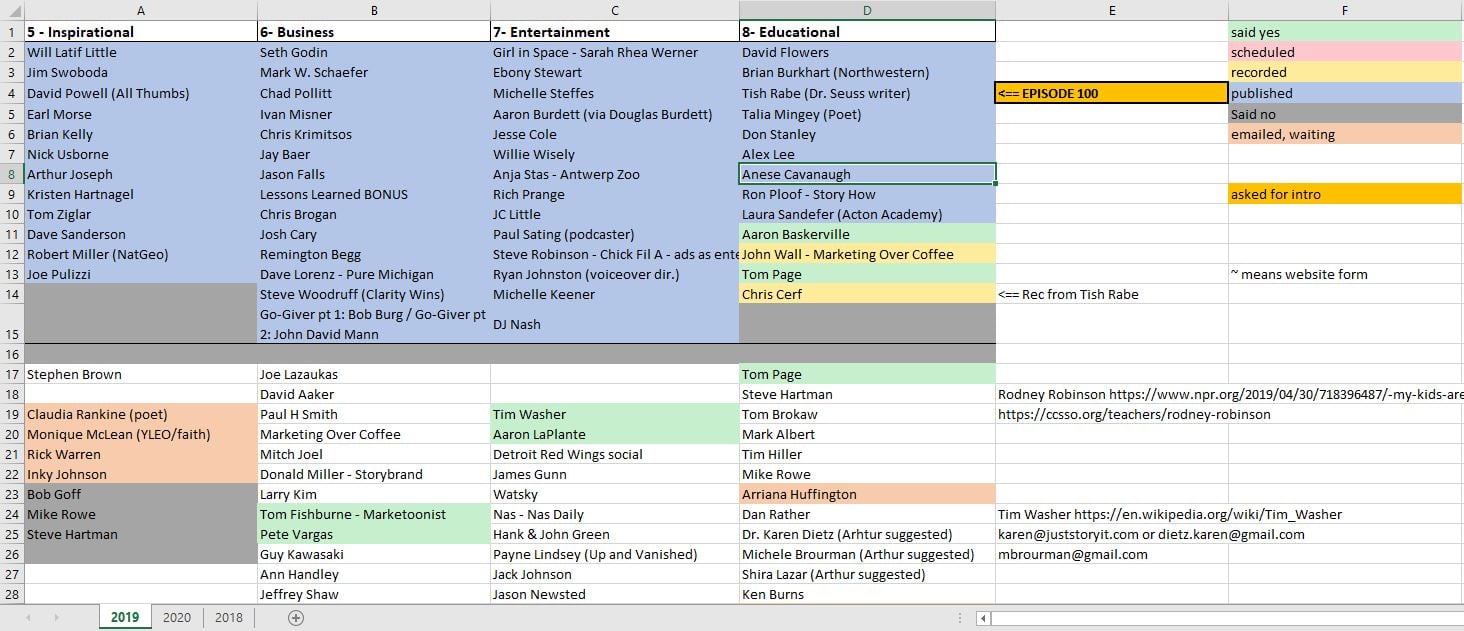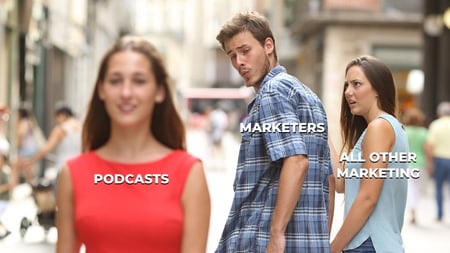Podcasts. They’re becoming the buzzword of the day for marketers.

While that can be annoying, especially if you’ve been podcasting for a while, it’s also a huge opportunity to try a new medium for many brands.
What does adding a podcast strategy to your marketing mix look like for your business? That depends.
In this article, we’ll explore how you can begin to think of podcasting as a micro-strategy within your greater marketing strategy.
Will you launch a podcast to reach customers? Do you want to interview potential business partners? Are you looking to position someone in your company as a thought leader? Will you entertain listeners?
Will you hire out the podcast production? Will you record and edit the podcasts yourself? Who will be the talent?
There’s a lot to think about when it comes to podcasting. Before you jump in head first without looking, let’s explore a few tips to add a podcast strategy to your marketing plan.
Grow Your Own Audience or Tap Into an Existing Audience?
If your goal is to build an audience you can sell to (think Kevin Kelly’s 1000 True Fans), you may want to consider something.
It takes time and effort to build an audience.
That’s not to say it isn’t worth it. Just know that launching a podcast takes time. And a lot of work.
But monetizing your audience by selling your services or products is a strategy others employ. Amy Porterfield and Pat Flynn are just a couple examples.
There’s also the idea of tapping into an existing audience on appearing as a guest on shows that make sense to your strategy.
Podcast interview marketing has helped tons of brands build awareness and drive leads. In fact there’s an entire industry of services to help you get on podcasts.
But the TL;DR version is this:
- Appear on podcasts as a subject matter expert
- Send listeners to your website (a custom landing page for each show is ideal)
- Build a following and net more shows
So which do you want to do?
Here’s a PRO TIP… it can be both! It doesn’t have to be one or the other. But if you have to decide on one tactic to focus on, decide which route is the lowest impact on your time and budget and test it out.
Video, Audio, Both?
A podcast is technically an audio medium. It’s an episodic series of digital audio files that a user can download in order to listen.
But in today’s multimedia world, a lot of podcasters also record and publish the video file.
So you have a decision to make: video, audio or both?
Wistia does both with Brandwagon. They publish a video show that feels like a Netflix-style late night interview program. Then they release more content in a podcast.
You could release the audio in a truncated version, like a 15-minute interview, then direct listeners to “hear the full conversation” on your video channel.
Your video could live on YouTube for search purposes if you optimize the listing well.
The bottom line is that you’ll want to decide how much work you can put into it, and where you want your show to appear. If you want it to truly be a podcast and appear in listings like Spotify, Apple Podcasts and other audio platforms, you’ll want to at least distribute the audio.
Interview Style, Monologue, Story?
With more than 750,000 podcasts in existence, there’s no shortage of niche content for us to consume. Styles vary as much as the creators themselves.
You can find podcasts where one host interviews a guest, two hosts interview a guest, the host or hosts simply riff on news of the industry like a monologue and shows that tell a story.
Podcasts exist that make you laugh, that get political, that inspire and that educate.
Some shows are 5-minute daily episodes (or shorter like The Creative Marketing Brief) and others can be hours long with sporadic release dates like The Joe Rogan Experience.
Other creators simply cut up clips from all kinds of sources and publish them as a podcast, which gives it an eclectic feel. See The GaryVee Audio Experience.
Your mission is to decide what’s right for you as the creator (you have to maintain the production) and your audience.
Plan Out a Schedule
As a podcast listener, there’s nothing worse than finding a great show with terrific content only to discover that they stopped at episode eight.
Podfade is a real thing. And you want to avoid it.

Avoid a false start by planning a specific number of episodes and devoting time to it.
As an example, let’s get personal for a minute. As the author, I reserve that right. 😉
For my podcast, The Storytellers Network, I plan a season each quarter. They all have themes and I have guests in mind I want to interview. I make sure I plan enough time to coordinate schedules, designate what interviews are agreed to and which are done and edited and then what’s been published.
Here’s a look at what that looks like in my spreadsheet at the time of this article.

However you decide to podcast, even if it’s being a guest, planning out a schedule to ensure you keep up with it will help you avoid podfade and keep track of your efforts.
Put Together a Launch Team
If you’ve decided to launch your own branded podcast, you want to make a splash when it launches. Here’s a quick look at eight steps to make that happen:
- Talk to family, friends, and business colleagues and let them know about your show. You can do this through text, calls, social media or email. You’re inviting them to join your email list.
- Create 3 emails that you are going to send to your email list. You’ll want one explaining the idea and your show, then inviting them to opt in. A second email will give them the details of what you want. The third gives them all the links. There’s a PDF here with templates for you.
- The key to remember here is that you don't want to ask for too much too soon. Keep the your discussion brief with those you meet in person. It's important to create an interest and you do this by keeping it mysterious - "I'm launching a new podcast soon, would you be interested in being a part of it? Yes? Great. I'm not quite there yet, but I'll send you an email on how you can help. Can I count on you?"
- Post on your social media.
- Share your artwork.
- Ask others to share your show.
- Create hype around a launch date.
- When you are ready, send your first email, one day later the second and one day later the third.
Create a Podcast Media Kit
You want people to listen to your podcast, don’t you? In addition to promoting your show in social and email, you should have a traditional means of telling your podcast story.
That packaging of your podcast's information for listeners, sponsors and journalists, in one convenient place is called a media kit, or press kit.
Yes, it’s added work. But your podcast’s success, however you measure it, is worth your time and energy.
A good media kit:
- Will help listeners to find and share your podcast
- Gives journalists key information for articles about your podcast
- Shows how your podcast is unique
- Tells your podcast story
- Condenses your podcast for future pitches
- Builds a relationship with sponsors
In short, a media kit is a parcel of information about your podcast that's easy to share and consume. Think of it as an appetizer sampler platter. It’s a condensed, snack-sized, flavorful version of your work, that makes listeners want more.
As part of your media kit, since it will likely be digital, add a shared folder with all of the assets related to your show. This will include your artwork and possibly a headshot of the host. Make you include high-quality, print-level and web versions. Also create a fact sheet (summary, intended audience, creators, history, the why, how to listen).
Finally, this may seem like a no-brainer, but make sure you include contact information for listeners, potential guests, sponsors and anyone else who may need to contact your show. Information may be different for each of these, but make sure it’s all there.
Build a Community
The final tip to adding a podcast strategy to your 2020 marketing plan, regardless of which podcast direction you take, is to build a community.
This may look like a private Facebook Group, and email list, a membership site, a Slack channel or some other means of connecting with listeners. But it’s important to make sure people can connect with you on some level.
Christopher Lochhead and Sprocket Talk are two examples of podcasts that create communities.
This tip is where you get to dream big and figure out what works for you brand. We won’t offer a ton tactics, because your community will grow with your ideas.
Bringing Your 2020 Marketing into Focus
At the time of this article’s publish date, 2020 is almost here. So we want to offer you the chance to bring your marketing efforts into focus before 2020 gets here.
However, whenever you’re reading this, it’s time to look at your next week, next month, next quarter or next steps in general.
Download our Strategic Roadmap and get started today, before it’s too late.





